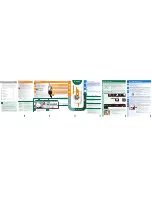
32
USEFUL HINTS FOR STAINLESS STEEL MAINTENANCE
Stainless steel is so called because it is not affected by oxidation, this is due to a thin molecular layer of oxide
on the surface which protects againts further oxidation. There are, however, substances which can modify or
destroy this layer, giving rise to corrosion: besides preventing the protective film of oxide from reforming, these
substances corrode the stainless steel itself and can cause irreparable damage. It is therefore necessary to
prevent this by choosing correct cleaning products and by complying with the following simple
recommendations:
never forget that, when using these appliances, the first and fundamental rule is to
guarantee that the cleaning products are both non-toxic and hygienic.
Before using any detergent to clean either the stainless steel or the immediate and sorrounding floor area,
always ask your supplier for the most suitable product which does not cause corrosion on the steel itself; the
onset of rust is most commonly caused by the use of unsuitable cleaning materials (strongly acid chlorate
based detergents) or on inadequate maintenance.
Our appliances are made of stainless steel AISI 304 (18-10 type) for exterior panelling, upper tops, tanks etc.
Comply with the following instructions when cleaning and servicing parts in stainless steel.
Ordinary daily maintenance
Carefully and frequently clean the surfaces by using a damp cloth; use soap and water or normal detergents,
so long as these do not contain abrasives or chlorine based substances
such as sodium hypochlorite
(bleach), hydrochloric acid or other such solutions: These products quickly and irreparably corrode stainless
steel. When cleaning floors underneath or near the appliances, never use the above mentioned products as
vapours or splashes could subject the steel to similar destructive effects.
Only ever rub in the direction of the satining, then thoroughly rinse with clean water and carefully dry.
Rust:
water supply pipes inevitably convey particles of rust dissolved in the water especially in new installation
plants or when taps are opened after a period of inactivity. These iron deposits must not be allowed to remain
on the stainless steel since they produce rust by contamination.
Use suitable products to remove any rust marks, from companies which produce detergents for industrial use.
After application, thoroughly rinse with clean water, neutralizing the action of the product with an alkaline
detergent normally used to clean such appliances or with another specific product.
DO NOT USE METAL MATS TO CLEAN THE STAINLESS STEEL
Summary of Contents for AA-08101
Page 2: ......
Page 57: ...HL1 KA3 30 10 2020 15 35...
Page 58: ...MS1 Pompa scarico Rigeneratore Acqua 30 10 2020 15 35...
Page 59: ...30 10 2020 15 35...
Page 61: ...YV5 BM 2 Valvola Scarico Rigeneratore Acqua 30 10 2020 15 35...
Page 62: ...HL1 KA3 30 10 2020 15 36...
Page 63: ...MS1 Pompa scarico Rigeneratore Acqua KA1 30 10 2020 15 36...
Page 64: ...30 10 2020 15 36...
Page 65: ...30 10 2020 15 36...
Page 66: ...30 10 2020 15 36...
Page 67: ...5 2 3...
















































